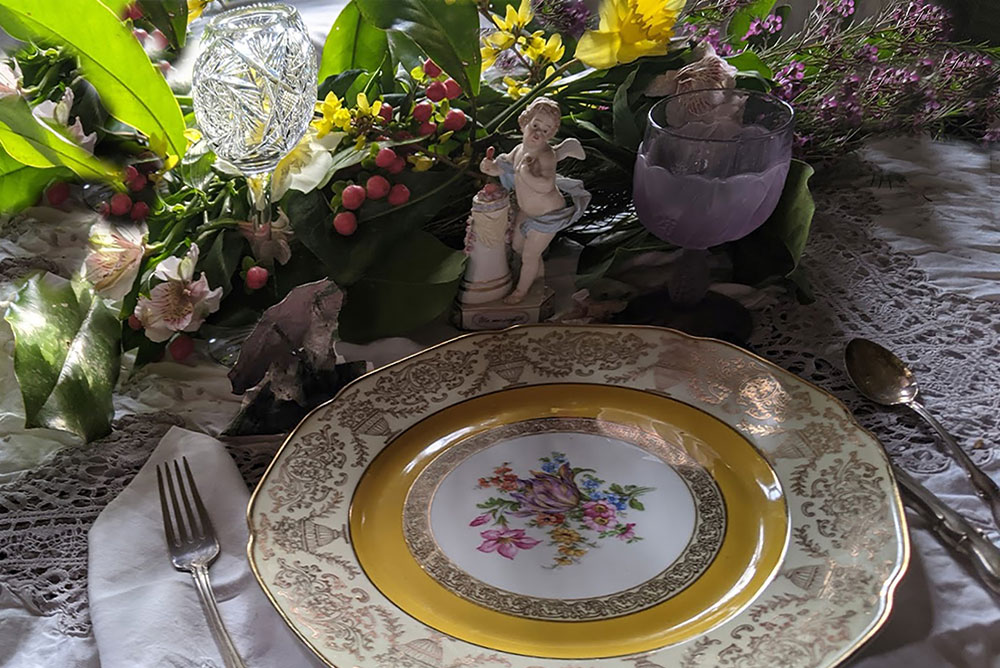
Tablescape and photo created by Stephanie Cavanaugh and Monica Weddle (a/k/a Baby) with flowers from the garden—and Trader Joe’s. / Photo by Stephanie Cavanaugh.
I THOUGHT I was done preparing seders. I ceded this to Baby several years ago, when she and her Personal Prince Pete bought their first house in Raleigh and she was ready to give it a go, which she did—and brilliantly.
I had painstakingly written out the instructions, a quasi-kosher meal (leave out the butter and leavened bread), that went from chopped liver to matzoh-ball soup to gefilte fish to brisket, asparagus, applesauce and potato pancakes/latkes (because, what don’t latkes go with?). Desserts are a mixed bag, usually disappointing: See the absence, above, of butter (because in kosher homes it is verboten to mix dairy products and meat). Macaroons, a really sad sponge cake, chocolate and strawberries, or some such fruit, are the stand-ins.
That was my mother’s meal, replicated: The only thing missing was an Aunt Ruthie, who always passed out midway from an overabundance of wine. She’d fall asleep on my parents’ bed, snoring until Uncle Al rousted her to go home. Our friends hold their wine better—but it could also be better wine.
This year Baby is here with her Baby Wes, and resuming her role as sous chef. What a joy. Maybe Pete will join us; that’s a little unclear. And because of the plague (wow! A real plague for Passover! Far out!) there will be only six of us, all vaccinated so theoretically safe from one another.
Passover means several things. The Jews fleeing slavery in Egypt, but also overcoming oppression so many times since—so we celebrate freedom. We do this with more food, of course. Bitter herbs (horseradish) and wine-sweetened nuts and matzoh (unleavened bread).
In brief, we say, after recalling these events: They tried to kill us, we survived, let’s eat. Jews do have a sense of humor, thank god.
Passover is also a celebration of family. So it’s pleasurable to make the meal my mama made and which was made by generations before her, laden with heart-clogging fat and washed down with cup after cup of wine. That we survive the meal is in itself a triumph.
Jews also have strong stomachs.
Passover is also, at root, a celebration of spring, of renewal, of bounty. So it pleases me as much to set the table as it is to serve the meal. It should look abundant, as heavy with adornment as it is with food.
The Haggadahs—the prayer books that guide us, that I grew up with—are trotted out, stained with decades of wine. This is the “revised edition,” dated 1945, so the echoes of horrors are particularly vivid. The linen and lace tablecloth that my parents brought back 50 years or so ago from Spain, covers the table, stretched to its limit with three boards. There are gold-bordered plates with flowery centers, the silver is polished, the crystal sparkles, and the centerpiece is a fantasy.
Greens are piled the length of the table with flowers in profusion (those little rubber-capped flower holders for water come in handy, though floral foam will also work). The garden usually has what I need: tulips and daffodils, grape hyacinth and wisteria, cherry blossoms, pansies and dandelions (did you know these last are related to sunflowers?). The festival comes early this year, so many of the flowers are not yet out and I’ll need to cheat. Trader Joe’s will assist in this.*
Tucked into the greenery are figurines, family treasures. Dancing putti, small animals, little vases—things that live through the year, ignored, in the curio cabinet, come out for this occasion to play. In the center is a French incense burner, lit with a votive candle. The holiday candles are at either end. And the prophet Elijah’s cup, such heavy-cut crystal, sits waiting . . .
For the eldest unmarried woman at the table to open the door at the proper moment and let Elijah in—where did that custom come from, I wonder. Do you do that too?
One would think, having made this meal and decorated the table the same way for 30-odd years that there would be one photo. There is not—chalk it up to the tumult of guests and food and drink—so Baby and I have brought out the essentials: dishes, crystal, flowers and putti, days before the event to give you a taste.
This year, maybe I’ll finally remember to take a photo before the meal. After would be fine too: There’s charm, and a new memory, in the dishabille.
L’chaim! To life.
*Toss in a couple of Easter eggs and this tablescape works for that celebration as well.
LittleBird “Stephanie Gardens” celebrates with flowers—and tchotchkes—anytime she can.

Lovely column. Chag Sameach.
I am not Jewish – but I almost wish I was when I read such beautifully, lyrical words! And as I read this I’m thinking/wondering if I could pull off such delightful floral decor for Easter. Then Lo & Behold you tell me I can. Though know it won’t match your Seder table!